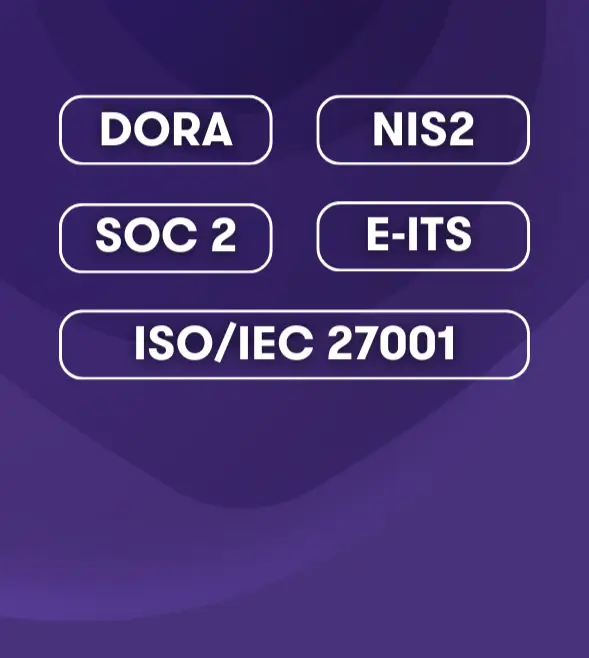-
Other audit services
We help clients with the application and use of foreign financial aid of EU and other funds and help prepare financial reports.
-
Audit calculator
The calculator will answer if the company's sales revenue, assets or number of employees exceed the limit of an inspection or audit.
-
Payroll and related services
We perform payroll accounting for companies whether they employ a few or hundreds of employees.
-
Tax accounting
Grant Thornton Baltic's experienced tax specialists support accountants and offer reasonable and practical solutions.
-
Reporting
We prepare annual reports in a timely manner. We help to prepare management reports and various mandatory reports.
-
Consolidation of financial statements
Our experienced accountants and advisors help you prepare consolidation tables and make the consolidation process more efficient.
-
Consultancy and temporary staff
Our experienced specialists advise on more complex accounting transactions, rectify poor historic accounting, and offer the temporary replacement of an accountant.
-
Outsourced CFO service
Our CFO service is suitable for companies of all sizes and in all industries. We offer services to our clients in the required amount and competences.
-
Assessment of accounting processes
We help companies to implement accounting practices that are in compliance with local and international standards.
-
Accounting services for small businesses
We offer affordable service for small businesses. We help organize processes as smartly and cost-effectively as possible.
-
Cryptocurrency accounting
We keep up with blockchain technology to serve and advise crypto companies. We are supported by a network of colleagues in 130 countries.
-
Trainings and seminars
Our accountants have experience in all matters related to accounting and reporting. We offer our clients professional training according to their needs.

-
Business advisory
We offer legal support to both start-ups and expanding companies, making sure that all legal steps are well thought out in detail.
-
Fintech advisory
Our specialists advise payment institutions, virtual currency service providers and financial institutions.
-
Corporate advisory
We advise on legal, tax and financial matters necessary for better management of the company's legal or organizational structure.
-
Transaction advisory
We provide advice in all aspects of the transaction process.
-
Legal due diligence
We thoroughly analyze the internal documents, legal relations, and business compliance of the company to be merged or acquired.
-
In-house lawyer service
The service is intended for entrepreneurs who are looking for a reliable partner to solve the company's day-to-day legal issues.
-
The contact person service
We offer a contact person service to Estonian companies with a board located abroad.
-
Training
We organize both public trainings and tailor made trainings ordered by clients on current legal and tax issues.
-
Whistleblower channel
At Grant Thornton Baltic, we believe that a well-designed and effective reporting channel is an efficient way of achieving trustworthiness.

-
Business model or strategy renewal
In order to be successful, every company, regardless of the size of the organization, must have a clear strategy, ie know where the whole team is heading.
-
Marketing and brand strategy; creation and updating of the client management system
We support you in updating your marketing and brand strategy and customer management system, so that you can adapt in this time of rapid changes.
-
Coaching and development support
A good organizational culture is like a trump card for a company. We guide you how to collect trump cards!
-
Digital services
Today, the question is not whether to digitize, but how to do it. We help you develop and implement smart digital solutions.
-
Sales organisation development
Our mission is to improve our customers' business results by choosing the right focuses and providing a clear and systematic path to a solution.
-
Business plan development
A good business plan is a guide and management tool for an entrepreneur, a source of information for financial institutions and potential investors to make financial decisions.
-
Due diligence
We perform due diligence so that investors can get a thorough overview of the company before the planned purchase transaction.
-
Mergers and acquisitions
We provide advice in all aspects of the transaction process.
-
Valuation services
We estimate the company's market value, asset value and other asset groups based on internationally accepted methodology.
-
Forensic expert services
Our experienced, nationally recognized forensic experts provide assessments in the economic and financial field.
-
Business plans and financial forecasts
The lack of planning and control of cash resources is the reason often given for the failure of many businesses. We help you prepare proper forecasts to reduce business risks.
-
Outsourced CFO service
Our CFO service is suitable for companies of all sizes and in all industries. We offer services to our clients in the required amount and competences.
-
Reorganization
Our experienced reorganizers offer ways to overcome the company's economic difficulties and restore liquidity in order to manage sustainably in the future.
-
Restructuring and reorganisation
We offer individual complete solutions for reorganizing the structure of companies.
-
Corporate taxation
We advise on all matters related to corporate taxation.
-
Value added tax and other indirect taxes
We have extensive knowledge in the field of VAT, excise duties and customs, both on the national and international level.
-
International taxation
We advise on foreign tax systems and international tax regulations, including the requirements of cross-border reporting.
-
Transfer pricing
We help plan and document all aspects of a company's transfer pricing strategy.
-
Taxation of transactions
We plan the tax consequences of a company's acquisition, transfer, refinancing, restructuring, and listing of bonds or shares.
-
Taxation of employees in cross-border operations
An employee of an Estonian company abroad and an employee of a foreign company in Estonia - we advise on tax rules.
-
Tax risk audit
We perform a risk audit that helps diagnose and limit tax risks and optimize tax obligations.
-
Representing the client in Tax Board
We prevent tax problems and ensure smooth communication with the Tax and Customs Board.
-
Taxation of private individuals
We advise individuals on personal income taxation issues and, represent the client in communication with the Tax and Customs Board.
-
Pan-Baltic tax system comparison
Our tax specialists have prepared a comparison of the tax systems of the Baltic countries regarding the taxation of companies and individuals.
-
Internal audit
We assist you in performing the internal audit function, performing internal audits and advisory work, evaluating governance, and conducting training.
-
Internal Audit in the Financial Services Sector
We provide internal audit services to financial sector companies. We can support the creation of an internal audit function already when applying for a sectoral activity license.
-
Audit of projects
We conduct audits of projects that have received European Union funds, state aid, foreign aid, or other grants.
-
Prevention of money laundering
We help to prepare a money laundering risk assessment and efficient anti-money laundering procedures, conduct internal audits and training.
-
Risk assessment and risk management
We advise you on conducting a risk assessment and setting up a risk management system.
-
Custom tasks
At the request of the client, we perform audits, inspections and analyzes with a specific purpose and scope.
-
External Quality Assessment of the Internal Audit Activity
We conduct an external evaluation of the quality of the internal audit or provide independent assurance on the self-assessment.
-
Whistleblowing and reporting misconduct
We can help build the whistleblowing system, from implementation, internal repairs and staff training to the creation of a reporting channel and case management.
-
Information security management
We provide you with an information security management service that will optimise resources, give you an overview of the security situation and ensure compliance with the legislation and standards.
-
Information security roadmap
We analyse your organisation to understand which standards or regulations apply to your activities, identify any gaps and make proposals to fix them.
-
Internal audit of information security
Our specialists help detect and correct information security deficiencies by verifying an organization's compliance with legislation and standards.
-
Third party management
Our specialists help reduce the risks associated with using services provided by third parties.
-
Information security training
We offer various training and awareness building programmes to ensure that all parties are well aware of the information security requirements, their responsibilities when choosing a service provider and their potential risks.
-
Digital Operational Resilience Act (DORA)
We will help you create a DORA implementation model that meets your company's needs and ensures that you meet the January 2025 deadline.

-
ESG advisory
We help solve issues related to the environment, social capital, employees, business model and good management practices.
-
ESG audit
Our auditors review and certify sustainability reports in line with international standards.
-
Sustainable investments
We help investors conduct analysis of companies they’re interested in, examining environmental topics, corporate social responsibility and good governance practices.
-
Sustainable tax behaviour
Our international taxation specialists define the concept of sustainable tax behaviour and offer services for sustainable tax practices.
-
ESG manager service
Your company doesn’t necessarily need an in-house ESG manager. This role can also be outsourced as a service.

-
Recruitment services – personnel search
We help fill positions in your company with competent and dedicated employees who help realize the company's strategic goals.
-
Recruitment support services
Support services help to determine whether the candidates match the company's expectations. The most used support services are candidate testing and evaluation.
-
Implementation of human resource management processes
We either assume a full control of the launch of processes related to HR management, or we are a supportive advisory partner for the HR manager.
-
Audit of HR management processes
We map the HR management processes and provide an overview of how to assess the health of the organization from the HR management perspective.
-
HR Documentation and Operating Model Advisory Services work
We support companies in setting up HR documentation and operational processes with a necessary quality.
-
Employee Surveys
We help to carry out goal-oriented and high-quality employee surveys. We analyse the results, make reports, and draw conclusions.
-
HR Management outsourcing
We offer both temporary and permanent/long-term HR manager services to companies.

-
Digital strategy
We help assess the digital maturity of your organization, create a strategy that matches your needs and capabilities, and develop key metrics.
-
Intelligent automation
We aid you in determining your business’ needs and opportunities, as well as model the business processes to provide the best user experience and efficiency.
-
Business Intelligence
Our team of experienced business analysts will help you get a grip on your data by mapping and structuring all the data available.
-
Cybersecurity
A proactive cyber strategy delivers you peace of mind, allowing you to focus on realising your company’s growth potential.
-
Innovation as a Service
On average, one in four projects fails and one in two needs changes. We help manage the innovation of your company's digital solutions!


Spring is here, which means it’s the time that many companies reporting their financial results have made the decision to pay out dividends. This brings up a number of questions for management and financial teams. We try to answer the most frequently asked ones below.
Basis for distributing dividends
The first and most important thing is to remember that dividends may be paid out only from retained earnings from previous periods and the precondition for paying dividends is an approved annual report and a shareholder resolution to distribute dividends. If a company receives a dividend and wishes to redistribute it to their shareholders, they must have enough retained earnings from previous periods to do so, or else the dividends will have to wait until the next financial year.
In practice, shareholders quite often will want to distribute profits from the ongoing financial year or from a financial year for which the accounts have not yet been approved. Here a problem arises with declaring and paying dividends. First of all, distribution of such earnings does not meet the definition of dividend set forth in the Income Tax Act, and due to that fact alone it should be declared as a profit allocation. Secondly, upon receiving a profit allocation, even if income tax has already been levied on it, a legal-person shareholder is not entitled to redistribute it tax-free. As a result such an approach is not the wisest for legal-person shareholders and to avoid an unfavourable outcome, it is better to wait until the annual report is approved and then make the decision to distribute dividends or use some other way to receive the funds earlier.
Taxation of dividends
In Estonia, the corporate tax rate for dividends is the 20% income tax rate on the gross amount (i.e. 25% from net payment). If a company pays dividends regularly – every year or at least once every two years – they incur the right to levy a 14% income tax rate on the average taxed (gross) dividend for the previous three years. Here it should be remembered that if lower-tax-rate dividends are distributed to shareholders who are natural persons, they are subject to an additional 7% income tax rate that is withheld from the natural person’s income. An exception is that, under tax treaties, residents of some jurisdictions enjoy a lower, 5% income tax rate or even a tax exemption.
Equal treatment in regard to distribution of dividends
Due to the income tax withholding requirement for disbursements made to investors who are natural persons, another problem comes up: what if a company’s investors are a mix of legal persons and individuals. The problem is equal treatment of these persons from the standpoint of taxation.
On one hand, it might seem that the easiest way is to decide that the net dividend amount is paid out proportionally for everyone and the withheld income tax ends up being an additional expense. This also seems logical if it is the initial distribution of the profit. But from that point on, if legal-person investors distribute their profits onward to natural persons tax-free, they still have the duty to withhold income tax on all disbursements made and as a result, the final dividend recipients receive less.
Thus the company should always analyse the optimal way to distribute dividends so that the beneficial owners do not wind up in worse position than the ones who receive the dividends upon initial distribution.
Tax exemptions and incentives for redistribution of dividends
If a company has previously received dividends from a company in which it had at least a 10% holding at the instant at which the dividends were received, and the dividends were taxable or paid from taxed earnings, the company has the right to redistribute the dividends tax-free.
If an Estonian company’s holding in a company paying the dividend was less than 10%, it does not have the right to redistribute the dividends tax-free. But the Estonian company does, upon redistributing the dividend, incur the right to deduct income tax paid in a foreign country from their payable income tax.
In both cases there is an important prerequisite: the dividends must be reported on Annex 7 of the TSD tax return. Otherwise, the Estonian tax authority will have no information that the dividends exist, and upon demand of the tax authority, Estonian companies must also be able to submit a certificate on income tax paid abroad.
Other observations
It should definitely be borne in mind that Estonia uses a cash-based taxation system – a decision to pay dividends by itself does not incur the obligation to pay income tax although the decision should already be recognized in financial accounts.
Regardless of the fact that the topic of distribution of dividends seems largely logical, even simple, many questions do come up in the case of more elaborate structures. Grant Thornton Baltic tax advisers are always ready to help.
The future
Pursuant to the new government’s coalition agreement, the income tax rate for companies will rise to 22% effective 1 January 2025. In addition, the reduced 14% rate on regularly paid dividends will be abolished – foreign owners will lose the most when this step is taken.
Thus, from January 1st 2025, a flat 22% rate will apply to (gross) dividends paid from own profits and other profit allocations. At the same time, the deferred (cash-based) corporate income tax system that Estonia is notorious for will remain in force, according to current plans.
There is currently no detailed information on the potential transitional provisions to be applied with regard to the three years’ average taxation base of dividends that currently are subject to a 14% discounted rate. Considering the principle of legitimate expectations, it would be proper if the balance of discounted rate dividends accumulating could be used to some extent after 2024 as well. But the preliminary unofficial information does not give much hope to businesses in this regard. It is expected that the draft law and related implementing provisions will become clear in early May, and then companies can better plan how much dividends to distribute and pay out in 2023 and 2024.
To sum up, we can expect increased dividend payments in the next 18 months, especially by foreign-owned companies.
If you have similar challenges and questions, please contact our specialists.












